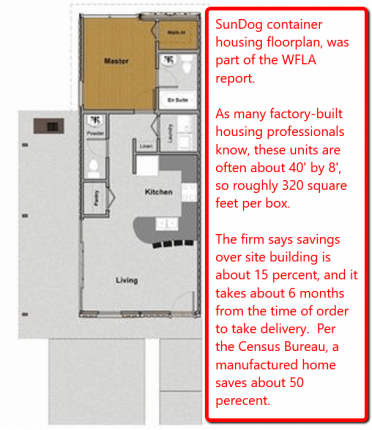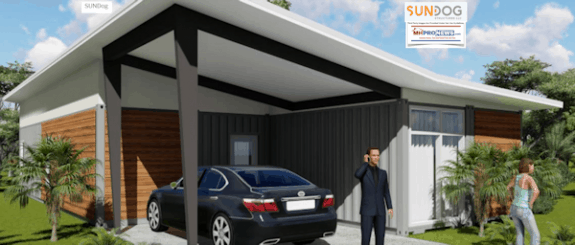
The report by WFLA, an NBC affiliate in Tampa, FL, is so glowing, one must wonder if the article and report were ‘commissioned,’ or a straight-news report.
The Daily Business News on MHProNews asked WFLA. Normally, mainstream news media are happy to say, unless it is a de facto advertorial, then they are less likely to reply. WFLA gave no reply.
But SunDog sales manager Miranda Piechowski told the Daily Business News on MHProNews that the firm has obtained other positive media from the Tampa Bay Times, and Channel 13, a local Fox affiliate. “Straight news,” Piechowski said.
The report by John Rogers included the video as shown, and the text looks like a close match for much of the narration of the video.
In a report that uses some hyperbole and is missing some data to back their claims, WFLA said, “The hottest trend in real estate across the U.S. is a 40-feet metal box. Container homes are taking the country by storm, and now the trend has made its way to Tampa Bay. In an effort to save money on a new home, more and more people are thinking outside the box and choosing to move into one instead.”
Scott Myers and his wife Emily Cusmano, per WFLA, said the pair looked at a SunDog container house as an option over a tiny house, and thought “‘I want to live in that!’”
“My wife and I, we’re really into efficient living and small living,” said Myers. The report says it will be the first one in Tampa, FL

The couple originally considered a tiny house, but they changed their minds after seeing how much bang for their buck they could get with a container home.
Theirs will be one of the first of its kind in Tampa.
“We got over [our concerns] pretty quickly when we realized how cool they were,” said Cusmano.
“We looked at custom builds, and it was almost double the price and it doesn’t give the look we’re gonna get from having this nice piece of house here,” said Myers.
WFLA said, “At SUNDog Structures, container homes can be built roughly $15 a square foot cheaper compared to the construction costs of a traditional home.
“Fifteen-dollars may not sound like a whole lot but when it comes to multiplying it by 2,500 times, it really adds up quickly,” said Cox.
The homes can be built on land you own – and fast. So while a foundation is laid, SUNDog will complete the house indoors in less than 160 days.
By building the homes in a warehouse, the workers can focus on quality and avoid exposure to the elements.
Officials say durability is what truly sets container homes apart compared to prefabricated or manufactured homes.”
The photos and illustrations shown were not part of the WFLA report.

The NBC affiliate said that, “SUNDog Structures provided this list of the pros and cons of container homes:”
The Pros Of Container Homes
There are many reasons that the container home trend is the newest “poster child” for the tiny house revolution. Here are a few of the biggest advantages of container homes! Take a look now, and see why they’ve become so popular.
- They’re incredibly affordable – Building a container home is affordable, and it’s within reach of many Americans who may be priced out of the traditional housing market. Container homes usually cost around $117-$125 per square foot.In contrast, the construction of a traditional home usually costs about $200 per square foot – at a minimum. This means that building a shipping container home – whether it’s permanent or mobile – will be much less expensive than a traditional home.And this has other benefits. The more you save when building your home’s structure and purchasing appliances, the more money you can spend on luxury items. You can afford better furniture, appliances, and even other luxuries like a spa, swimming pool, solar panels, and so forth.
And not only are container homes affordable to buy, they’re affordable to live in. You can use solar panels and rainwater tanks to save on utility bills, and insulate your home to ensure that it does not consume too much power.
The more you save on construction and utilities, the more luxuries you can afford! And that’s a good thing.
- Eco-friendly and sustainable – This is a huge benefit for anyone who is concerned about their environmental footprint, and wants to think globally and act locally. The process of building a traditional home is quite resource-intensive, and requires a lot of supplies and materials that must be shipped from around the world, increasing your carbon footprint. Traditional homes also often require a large plot of land to be cleared of grass, plants, trees, and more, to prepare for construction and the pouring of a foundation, which means you’ll damage your local environment when you build one. In contrast, shipping container homes are built from recycled materials, making them more environmentally-friendly. And they can even be built in a factory, which means less transportation of materials, and a lower carbon footprint.
Their eco-friendly design extends further than just construction. You can build your home with solar water tanks and solar panels and other features that make you less reliant on local power, which means you’ll reduce the impact you have on your surrounding environment.
So if you’re interested in “going green”, a shipping container home is one of the best ways to do so. You can make the most out of a small space, and make sure that you don’t damage your environment.
- You can customize every part of your home – With a company like SUNDog Structures, you’re in complete control of how your home is built. Whether you’re interested in a mobile shipping container home, or a permanent structure, you can work with experienced designers to create a shipping container home that lives up to your vision of an ideal home. This means you’ll get exactly what you want – and you don’t have to just accept a pre-built home from a developer, which can’t be changed and modified. Whether you want a “green roof” which can support plants and grass, a window that takes up an entire side of your container, or home office underneath your loft bed, you can build the home you’ve always wanted.
- They can be built very quickly – Shipping container homes can be built in just a few weeks, especially if they are made from only one or two containers, and are designed to be mobile. The home can be built in a factory, and ready in less than a month. In contrast, it can often take a year or more for a traditional developer to complete the process of building a home, and even longer for it to be ready for habitation by you and your family.
These are just a few reasons that container homes are becoming so popular, especially among younger folks. They’re affordable, flexible, customizable, and environmentally friendly!
The Cons Of Container Homes
Container homes are great – but because they’re a relatively recent innovation, there are some drawbacks that you may need to be aware of, before you commit yourself to purchasing one. Let’s look at some of these disadvantages now.
- Zoning and building permit acquisition may be complex – Building permits, zoning codes, and other local municipal ordinances may make it hard to get permission to build a permanent home out of shipping containers – or bar you from placing a mobile container home on your property. Most local city councils and lawmakers don’t really know much about shipping container homes, and their outdated laws reflect this. Before you begin construction, you must research your local planning regulations. They may specify things like disallowed building materials, the minimum size of a home, and other such guidelines that your container home must abide by.
Building permits take time to be approved, and it may take longer for you to get approval when building a container home, compared to a traditional home. Be prepared for this, and make sure you double-check with all local zoning and inspection departments for approval – before construction begins.
- They’re small (if they’re mobile) – Shipping containers provide about 320 square feet of area, and this means that they are very small, particularly if you build a mobile home, and use just one container. If you have lived in small spaces before, you won’t have any issues – but if you’re used to more spacious living situations, this may be hard for you to get used to.We recommend you do some research, and visit some other tiny homes and mobile homes to make sure that you are up to the task of living in a small home.
- Offsite construction may be required – This could be a pro or a con, depending on your perspective. While it’s nice to have your home built offsite – because it’s fast and efficient – you can’t be very involved in the process, unless you live near the factory where your home is being built, which is unlikely. This is a potential drawback. However, if you don’t mind, and you trust your contractors to make your home look perfect even without your oversight, this could actually be a benefit! Your dream home will be delivered right to your property!
- It may be hard to find an experienced contractor – Again, this drawback is primarily related to how new container homes are. Most builders and developers have never worked with shipping containers, and they won’t really know how to build a home using shipping containers – which could mean you’ll have to settle for an inexperienced contractor. However, there are some contractors who have years of experience working with tiny homes and container homes all around America, such as SUNDog Structures. If you can find the right contractor, you don’t have to worry about this drawback!
While container homes have a number of advantages, there are some quirks and drawbacks associated with building one, so make sure you understand the disadvantages we’ve outlined above!”

Sit Up and Take Notice
Once more, manufactured and modular home producers should take note. They are positioning their product – which is certainly their right – in ways that aim for the HUD Code or modular buyer.
ICYMI, or need a refresher, see the report about a Jeff Bezos/Amazon investment unit that has made a bet on prefab housing, in the related reports, further below.
That’s this morning’s “News through the lens of manufactured homes, and factory-built housing,” © where “We Provide, You Decide.” © ## (News, analysis, and commentary.)
(Related Reports are further below. Third-party images and content are provided under fair use guidelines.)
1) To sign up in seconds for our MH Industry leading emailed news updates, click here.

2) To pro-vide a News Tips and/or Commentary, click the link to the left. Please note if comments are on-or-off the record, thank you.
3) Marketing, Web, Video, Consulting, Recruiting and Training Re-sources

Related Reports:
$300 Billion Market, As Predicted, Jeff Bezos’ Amazon Alexa Fund Dives Deeper into PreFab Homes
Container Houses for Under $40,000, Transported by Flatbed, Construction, LifeStyle Videos
Billion Dollar Startup Modular Builder, Using Robotics, Could Soon Rival Clayton Homes’ Total Sales
Survey Top 2017 PreFab, Modular, Tiny and 3D Printed Housing News Stories

























